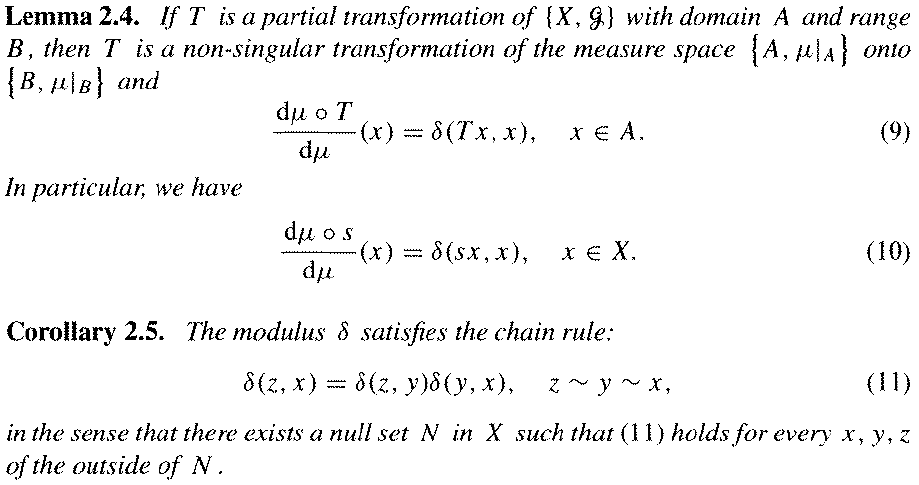Conclusion: this action of $\mathbb{F}_2$ on $\mathbb{S}^1$ generates a non-hyperfinite ${\rm III}_1$ factor $\mathcal{M}$.
Let $\Omega$ be a cyclic-separating vector (i.e. $\mathcal{M}\Omega$ and $\mathcal{M}'\Omega$ dense in $H$) and $\sigma=(\sigma_t^{\Omega})$ be the one-parameter modular map. Then $\mathcal{M} \rtimes_{\sigma} \mathbb{R} $ is isomorphic to $\mathcal{N} \otimes B(H)$, with $\mathcal{N}$ a ${\rm II}_1$ factor (independent up to iso. of the choice of $\Omega$) of fundamental group $\mathbb{R}_{+}^*$.
Question: What is $\mathcal{N}$? Is it isomorphic to $\mathcal{L}(\mathbb{F}_2)$?
If so, it would solve the free group factors isomorphism problem, according to this paper of Florin Rădulescu.
Remark: If we replace $s:x \mapsto x^2$ by $s_n: x \mapsto x^n$ with $n \ge 2$, we generate a von Neumann algebra $\mathcal{M}_n$ which is also a non-hyperfinite ${\rm III}_1$ factor (the proof is similar). Are they isomorphic?
It should work as well if we replace $s$ by any bijection of $[0,1)$ polynomial of degree $\ge 2$.
Conclusion: this action $\alpha$ of $\mathbb{F}_2$ on $\mathbb{S}^1$ generates a non-hyperfinite ${\rm III}_1$ factor $\mathcal{M}$.
Let $\Omega$ be a cyclic-separating vector (i.e. $\mathcal{M}\Omega$ and $\mathcal{M}'\Omega$ dense in $H$) and $\sigma=(\sigma_t^{\Omega})$ be the one-parameter modular group. Then $\widetilde{\mathcal{M}}:=\mathcal{M} \rtimes_{\sigma} \mathbb{R} $ is a ${\rm II}_{\infty}$ factor called the core of $\mathcal{M}$.
It is independent (up to isomorphism) of the choice of $\Omega$, and is isomorphic to $\mathcal{N} \otimes B(H)$, with $\mathcal{N}$ a non-hyperfinite ${\rm II}_1$ factor of fundamental group $\mathbb{R}_{+}^*$.
By Theorem 2.23 below, $$\widetilde{\mathcal{M}} = L^{\infty}(\mathbb{S}^1 \times \mathbb{R}_{+}^*, Leb) \rtimes_{\widetilde{\alpha}} \mathbb{F}_2$$ where the action $\widetilde{\alpha}$ of $\mathbb{F}_2$ on $\mathbb{S}^1 \times \mathbb{R}_{+}^*$ is given by $$\gamma(x,\lambda) = (\gamma(x), [\gamma'(x)]^{-1}\lambda),$$ with $x \in \mathbb{S}^1$, $\lambda \in \mathbb{R}_{+}^*$ and $\gamma \in \mathbb{F}_2$ identified with $\alpha(\gamma)$ or $\widetilde{\alpha}(\gamma)$ when appropriate.
Remarks and questions:
Note that $\widetilde{\mathcal{M}}$ has a Cartan subalgebra. Can we deduce that $\mathcal{N}$ has also a Cartan subalgebra?
If so, $\mathcal{N}$ cannot be isomorphic to $L(\mathbb{F}_2)$, because this last has no Cartan subalgebra, by this paper of Dan Voiculescu. Anyway, can we deduce that $L(\mathbb{F}_2)$ has also for fundamental group $\mathbb{R}_{+}^*$?
If so, it would solve the free group factors isomorphism problem, according to this paper of Florin Rădulescu.
Extracts of the following book of Masamichi Takesaki (pages 28 and 17):
The result below provides the core $\widetilde{\mathcal{R}}$ of the crossed-product $\mathcal{R}$.
From Corollary 2.5 below, $\delta(x,sx) = \delta(sx,x)^{-1}$, whereas Lemma 2.4 provides $\delta(sx,x)$.




